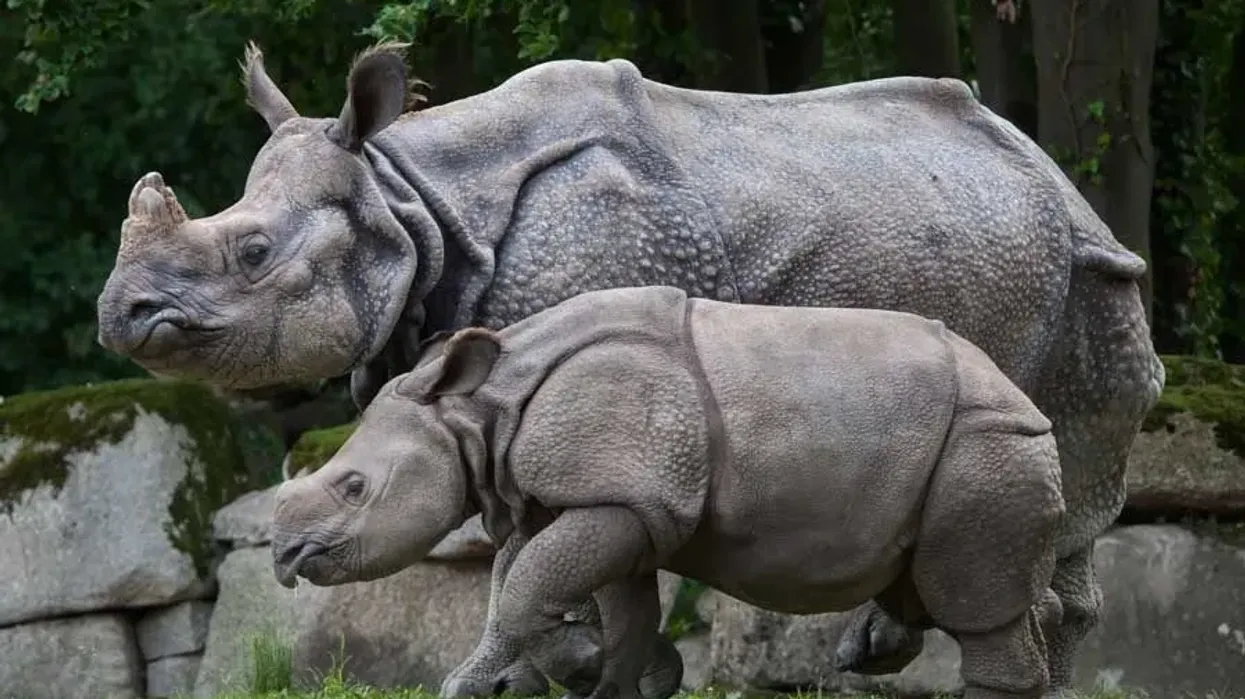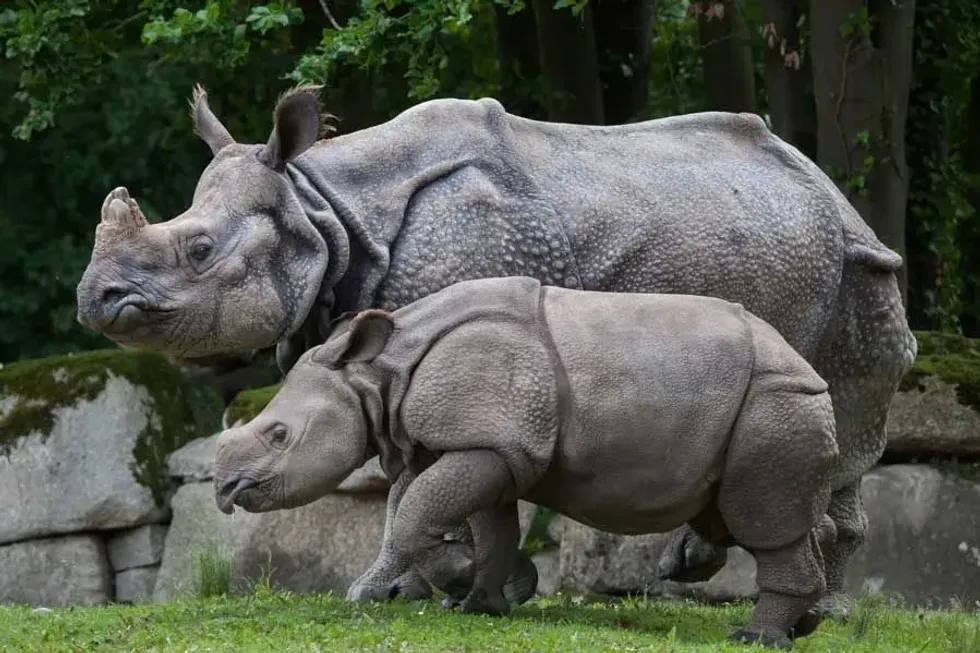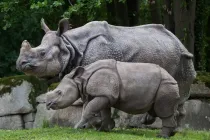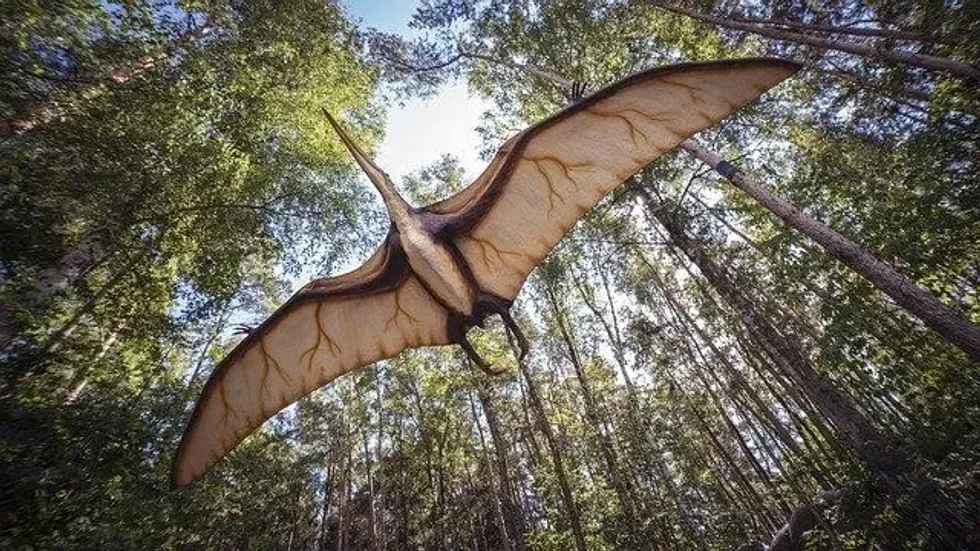Fun Indian Rhinoceros Facts For Kids

The Indian Rhino, the greater one-horned Rhino, the great Indian rhinoceros, is a majestic animal. The population of Indian Rhino can be found across the subcontinent of India and Nepal, and the major part of it is in protected areas of Kaziranga.
The population of the Rhino, greater one horned Rhino, is considered to have a lower population than that of the famous wild black rhino. These wild herbivores love eating plants and berries and can live up to 50 years.
Its habitat is formed by areas that have large and fresh grass with flowers and buds.
The Indian Rhino's baby is called a calf, and it is a very adorable creature. The Indian Rhino's horn is visible in both males and females of the Indian rhino.
This species is solitary and these animals are not very territorial. The Indian Rhino tends to form groups only in particular conditions, like while mating. Historically speaking, the species like Sumatran rhino or the Javan rhino were also found in India.
But they are extinct today. This population species used to roam freely along the Ganges or Indus rivers.
But these rhinos are on the brink of extinction owing to large-scale hunting. The only predator that hunts the population of rhinoceros species is humans. An Indian rhino's horn is of great value to wildlife poachers like that of a black rhino's, a type of Indian Rhino.
Also check out fact files leopard seal and fennec fox at Kidadl.
Indian Rhinoceros Interesting Facts
What type of animal is an Indian Rhinoceros?
Indian Rhinoceros (Rhinoceros unicornis) are also known as greater one-horned rhinoceros, the largest of the three Asian rhinoceros.
What class of animal does an Indian Rhinoceros belong to?
Indian Rhinoceros, known as greater one horned rhinoceros, belongs to the class Mammalia.
How many Indian Rhinoceros are there in the world?
There are close to 3,600 one-horned rhinoceros in the world, spread across different parts of India and Nepal.
Where does an Indian Rhinoceros live?
Tropical bushland, grasslands, savannahs form a significant part of their habitat.
What is an Indian Rhinoceros' habitat?
The natural habitat of an Indian Rhinoceros (Rhinoceros unicornis) ranges across northern India and Nepal, but that variety has been drastically diminished because of excessive hunting. The greater one horned rhino species can be found in the protected areas of Kaziranga in the Indian subcontinent.
At present, the range is confined to tall grasslands and forests surrounding the Himalayas Mountain range.
Who do Indian Rhinoceros live with?
Indian Rhinoceroses are usually solitary animals like the black rhinos but form groups only at times of mating.
How long does an Indian Rhinoceros live?
The average lifespan of a Greater one horned Rhinoceros ranges from 35-45 years.
How do they reproduce?
Indian Rhinos are species of animals that reproduce every two and a half to five years. A female will copulate with the male and breed the calf. Female Indian Rhinos carry their calves during the gestation period ranging from 15 to 16 months.
What is their conservation status?
By the onset of the 20th century, there were around 500,000 that roamed in Africa and Asia. The number fell to 70,000 by 1970, and today around 3,600 Indian rhinos remain in the wild.
The country's first conservation law in 1957 ensured the protection of one horned rhinos and their habitats. Several protected national parks and reserves had been developed to preserve one horned rhino from persistent poaching and loss of habitat over decades.
After every three years, a survey is conducted by wildlife officials to check whether there is an increase in the populations of rhinos. Special patrol teams were with armed men, and a network of outposts was formed at Kaziranga to guard the one horned rhinos against poachers. Indian rhinos were also reintroduced in areas where they had previously inhabited.
As of now, this species is restricted to only about 11 protected reserves in India and Nepal. Special Programmes were conducted to introduce artificial breeding so as to increase the number of Indian rhinos in captivity.
The conservation struggles have led to an improvement in the rhino population from 200 at the end of the 20th century to around 3,600 today. The status has improved from endangered to vulnerable due to significant population increase because of successful conservation efforts.
Indian Rhinoceros Fun Facts
What do Indian Rhinoceros look like?
Indian Rhinoceros (greater one horned rhinoceros) have brownish-grey skin with folds that look like armor, raised bumps on their neck, shoulder, and legs. They have a heavy skull, flexible ears, an avaricious upper lip, and a bulky body with a short tail.
The subcutaneous fat present under the skin helps in thermo-regulation, which means that these animals can regulate their body temperature in varying weather conditions.
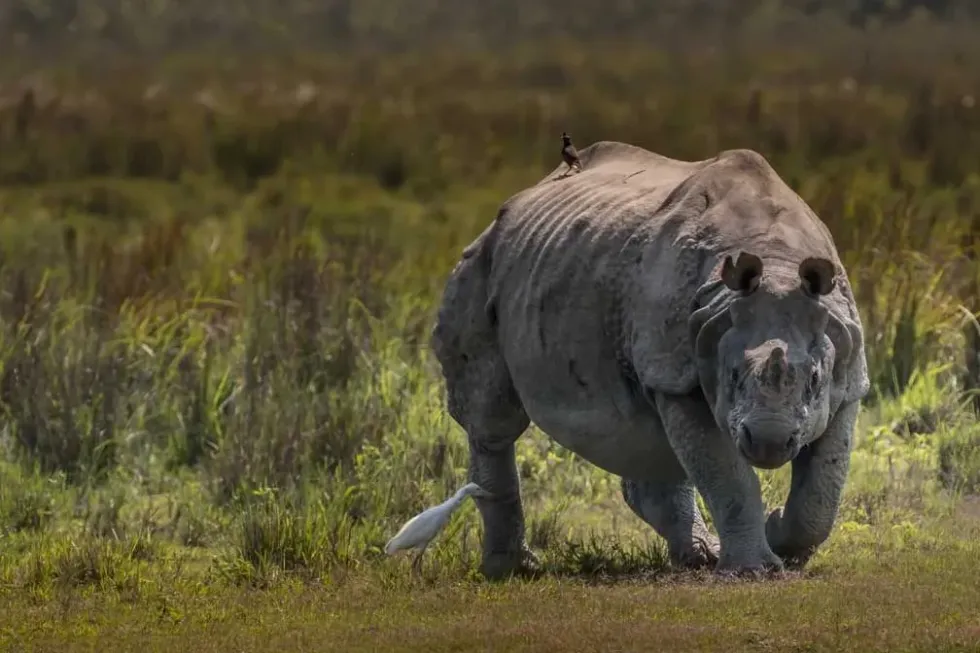
How cute are they?
Indian Rhinos are of massive size, beautiful animals. The greater one horned rhino calf is a small, cute and playful creature. But one should not be deceived by their small size as they are mighty.
How do they communicate?
Indian Rhinos use their vocal sounds for communicating with one another. There are various different sounds within its vocalizations, used to convey different messages depending on the situation.
The sounds include squeals, growls, moos, snorts, and even trumpet sounds. Let's see some examples and understand some of the sounds: Rhinos start screaming to indicate fright, terror, or a dire appeal to the calf to get to safety. They also use panting to convey different messages, and the speed and pattern of panting differ according to the messages.
It is used to indicate other rhinos to join up in the face of danger. Rhino dung heaps also serve as points of communication and marks of territorial boundaries.
Some research also suggests that they use infrasonic sounds that are below the range of human hearing to communicate with other rhinos. Body language is also another way of communicating with one another.
Flattening of their ears means warning an another animal, rubbing the sides of another rhino show affection, bashing their heads on bushes show off aggression. Calves swing their heads, which is an invitation for others to play with them or erect their ears when they become curious over anything.
How big is an Indian Rhinoceros?
The Indian Rhino is the second-largest rhinoceros species. The length at the shoulder of an Indian rhinoceros varies from 170-200 cm (67-79 in). This makes them at least two times larger than a German shepherd and at least eight times larger than an adult rabbit.
How fast can an Indian Rhinoceros move?
An Indian Rhinoceros can run at a maximum speed of 34mph, which makes it almost two times faster than the African elephant.
How much does an Indian Rhinoceros weigh?
An Indian Rhinoceros, also called greater one horned Rhino, can weigh between 1,600-2,200 kg (4,000 to 6,000 lb.) which makes them at least four times heavier than an American Bison and at least 16 times heavier in size than a full-grown Anaconda.
What are their male and female names of the species?
Male Indian rhinos are often called bulls, while the female Indian rhinos are called cows.
What would you call a baby Indian Rhinoceros?
A baby Indian Rhinoceros is called a calf.
What do they eat?
Indian Rhinos (Rhinoceros unicornis) are herbivorous animals. Their diet mainly consists of leaves from the densely vegetated sub-tropical forest, flowers, buds, fruits, berries, and roots that they dig up from the ground using their horns.
As they live across a fertile grassland plain, their diet also consists of tall grasses, which form the majority of their diet. During hot summer days, they dip themselves in nearby mud holes and ponds or rivers and consume aquatic plants that they encounter.
Are they dangerous?
Yes, Indian Rhinos are very dangerous and can inflict heavy lethal wounds. They fight with their lower outer incisor teeth which is razor sharp and not with horns. The teeth can reach lengths up to 13 cm or 5 inches among dominant males.
They compete with other dominant males in order to breed with females in wild habitats. Their skin folds look like armor. The skin of the greater one horned Rhinoceros looks brownish grey with raised bumps on the neck, shoulder, and legs.
Would they make a good pet?
Indian Rhinoceros are considered to be vulnerable animals, and therefore, they should not be kept as pets. However, one can symbolically adopt a rhino as a gift either in their own name or for a friend or family who supports wildlife conservation. They can do so in order to protect the species from getting endangered.
Did you know...
One unknown fact about why poaching was so common in the late 19th and 20th century is because of sport hunting that was common at that time. Their populations declined severely as the one horned rhinos were hunted relentlessly and persistently.
Illegal trading of horns has resulted in the killing of one-horned rhinos and are bought and consumed by wealthy people purely as a symbol of wealth.
Another predatory threat that the one horned rhino calves face is tigers. Around 10-20 percent of calves are killed by tigers every year, and those that survive past that point become invulnerable to nonhuman predators.
Another interesting fact of the greater one-horned rhinoceros: they are good swimmers and can dive and feed aquatic plants underwater. Well, many people think that the horn of a one horn rhinoceros is used for fighting, which is absolutely wrong.
The horn is used primarily for searching for food and for foraging for roots.
The horns are made up of keratin, same as human fingernails, and re-grows if broken off. The length of a typical horn of a one horn rhino species can vary between 2061 cm and can weigh up to 3 kg.
How many Indian rhinos are left?
The Indian Rhinoceros (Rhinoceros unicornis), also known as greater one horned rhinoceros, are now considered vulnerable wildlife, although previously from endangered. This is because of successful conservation efforts by individuals as well as various wildlife organizations and governments.
The destruction of habitat is one of the greatest threats that these species have been facing. Poaching and lack of diversity in their living sites are some of its other threats. Sport hunting of rhinos was widespread in the past, as a result of which their population is vulnerable today.
After 1975, when they became endangered, various schemes, programs, and policies were introduced to safeguard the one horned rhinos from illegal poaching activities of Indian rhino horns. As of now, the population has surpassed 3,700 in numbers and continues to grow, because of successful efforts of organizations.
How many tusks does an indian rhinoceros have?
They do not have a tusk. But they have a single horn. A rhino horn is precious.
Here at Kidadl, we have carefully created lots of interesting family-friendly animal facts for everyone to discover! Learn more about some other mammals including Sumatran orangutan, or plains zebra.
You can even occupy yourself at home by drawing one on our Indian Rhinoceros coloring pages.
We Want Your Photos!
More for You
See All
Bachelor of Science specializing in Mass Communication.

Adekunle Olanrewaju JasonBachelor of Science specializing in Mass Communication.
Bachelor of Law

Abdulqudus MojeedBachelor of Law
A versatile professional with a passion for creative writing and technology. Abdulqudus is currently pursuing his Bachelor of Law from the University of Lagos and has experience as a tutor, intern assistant, and volunteer. He possesses strong organizational skills and is a detail-oriented person.
Disclaimer
1) Kidadl is independent and to make our service free to you the reader we are supported by advertising. We hope you love our recommendations for products and services! What we suggest is selected independently by the Kidadl team. If you purchase using the Buy Now button we may earn a small commission. This does not influence our choices. Prices are correct and items are available at the time the article was published but we cannot guarantee that on the time of reading. Please note that Kidadl is a participant in the Amazon Services LLC Associates Program, an affiliate advertising program designed to provide a means for sites to earn advertising fees by advertising and linking to Amazon. We also link to other websites, but are not responsible for their content.
2) At Kidadl, we strive to recommend the very best activities and events. We will always aim to give you accurate information at the date of publication - however, information does change, so it’s important you do your own research, double-check and make the decision that is right for your family. We recognise that not all activities and ideas are appropriate for all children and families or in all circumstances. Our recommended activities are based on age but these are a guide. We recommend that these ideas are used as inspiration, that ideas are undertaken with appropriate adult supervision, and that each adult uses their own discretion and knowledge of their children to consider the safety and suitability. Kidadl cannot accept liability for the execution of these ideas, and parental supervision is advised at all times, as safety is paramount. Anyone using the information provided by Kidadl does so at their own risk and we can not accept liability if things go wrong.
3) Because we are an educational resource, we have quotes and facts about a range of historical and modern figures. We do not endorse the actions of or rhetoric of all the people included in these collections, but we think they are important for growing minds to learn about under the guidance of parents or guardians.
